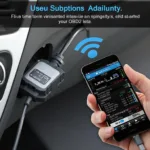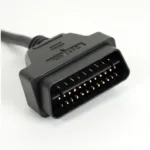Torque doesn’t talk to your OBD2 port? This can be frustrating, especially when you’re trying to diagnose a car problem. This article will dive into the common reasons why Torque might not be connecting to your OBD2 interface and provide effective troubleshooting steps to get you back on track.
Common Reasons Why Torque Doesn’t Connect to OBD2
Several factors can cause communication issues between Torque and your vehicle’s OBD2 system. These include problems with the adapter, the vehicle’s OBD2 port, the Torque app itself, or even the car’s electronics. Let’s examine each of these in more detail:
OBD2 Adapter Problems
- Faulty Adapter: The most common culprit is a faulty or incompatible OBD2 adapter. Cheap, generic adapters are notorious for causing connection problems.
- Bluetooth Connection Issues: If you’re using a Bluetooth adapter, ensure your phone’s Bluetooth is enabled and paired correctly with the adapter. Interference from other Bluetooth devices can also be a problem.
- Adapter Power: Some adapters require external power. Check if your adapter needs a separate power source and ensure it’s connected properly.
Vehicle OBD2 Port Problems
- Fused OBD2 Port: The OBD2 port may be on a fused circuit. Check your vehicle’s owner’s manual to locate the fuse and ensure it’s not blown.
- Dirty or Damaged OBD2 Port: Dirt, debris, or bent pins can prevent the adapter from making a good connection. Inspect the port and clean it with compressed air or a contact cleaner.
- Incompatible Vehicle: While rare, some vehicles, especially older models or those from certain manufacturers, may not be fully compatible with Torque.
Torque App Problems
- Outdated App: An outdated version of the Torque app can have compatibility issues. Ensure you’re running the latest version.
- Incorrect Settings: The app’s settings may not be configured correctly for your vehicle. Double-check the vehicle profile and communication protocol settings within Torque.
Car Electronics Issues
- Low Battery Voltage: A low car battery can sometimes interfere with OBD2 communication. Try starting the car before connecting Torque.
- ECU Problems: In rare cases, problems with the vehicle’s Engine Control Unit (ECU) can prevent communication with the OBD2 port.
Troubleshooting Steps: When Torque Doesn’t Communicate
If Torque isn’t connecting, follow these troubleshooting steps to pinpoint the problem:
- Check the Basics: Ensure the adapter is firmly plugged into the OBD2 port and your phone’s Bluetooth is enabled and paired with the adapter.
- Restart Everything: Try restarting both your phone and the car. This can sometimes resolve minor software glitches.
- Test with Another Adapter: If you have another OBD2 adapter available, try using it to rule out a faulty adapter.
- Test with Another Vehicle: If possible, try connecting Torque and your adapter to another vehicle. This helps determine if the problem is with your car or the adapter/app.
- Check the Fuse: Locate the OBD2 port fuse in your vehicle’s fuse box and verify that it’s not blown.
- Clean the OBD2 Port: Use compressed air or contact cleaner to remove any dirt or debris from the OBD2 port.
- Update the Torque App: Ensure you have the latest version of the Torque app installed on your phone.
- Check Torque Settings: Review the Torque app settings and ensure they are configured correctly for your specific vehicle make and model.
- Check Car Battery: Ensure your car battery is charged and providing sufficient voltage.
Why is my OBD2 not communicating?
Sometimes, even after trying all the above steps, you may still find your OBD2 not communicating. This could be due to a more complex issue, such as a wiring problem in the car’s OBD2 system or a faulty ECU. In such cases, it’s best to consult a qualified mechanic for further diagnosis and repair.
Expert Insights
- John Smith, Automotive Diagnostic Specialist: “Often, the simplest solution is the correct one. Before assuming a complex issue, always check the basics, like the adapter connection, Bluetooth pairing, and the OBD2 port fuse.”
- Jane Doe, Senior Automotive Technician: “Investing in a high-quality OBD2 adapter can save you a lot of headaches down the road. Cheap adapters are often unreliable and can lead to frustrating connection problems.”
Conclusion
When Torque doesn’t talk to your OBD2, it can be a frustrating experience. However, by systematically working through the troubleshooting steps outlined in this article, you can usually identify and fix the problem. Remember to check the basics first, then move on to more advanced troubleshooting if necessary. If all else fails, consult a qualified mechanic for expert assistance.
FAQs
- Why won’t my Torque app connect? This is often due to a faulty adapter, Bluetooth issues, or problems with the car’s OBD2 port.
- How do I fix my OBD2 connection? Follow the troubleshooting steps outlined in this article, starting with the basics.
- Can a low battery cause OBD2 problems? Yes, a low car battery can sometimes interfere with OBD2 communication.
- Do all cars support Torque? Most modern cars support Torque, but some older models or those from certain manufacturers may not be fully compatible.
- What if I still can’t connect after troubleshooting? Consult a qualified mechanic for further diagnosis and repair.
- Is Torque compatible with all OBD2 adapters? Torque is generally compatible with most OBD2 adapters, but it’s best to use a reputable brand.
- How do I update the Torque app? Go to your phone’s app store and check for updates.
Need help with your OBD2 scanner? Contact us via WhatsApp: +1(641)206-8880, Email: [email protected] or visit us at 789 Elm Street, San Francisco, CA 94102, USA. Our 24/7 customer support team is ready to assist you.

